Yellow Pigeon Blood Discus
$63.00 – $193.00
Some collectors enjoy a full pronounced bodied pattern. Others enjoy a “fadeaway” effect where the pattern begins to disappear towards the tail of the fish. We carry both flavors. Simply indicate your preference in the comments box in your order.
This peaceful strain has reddish-orange eyes and a gorgeous bright-yellow checkerboard pattern over a white to cream base color. The tail is clear with subtle touches of yellow or orange. The dorsal and caudal fins may have a black edge. The overall coloration is breathtaking. This strain is designed to spread warmth throughout your aquarium due to their distinctive yellow coloration, which lends unparalleled beauty. Brighten your tropical freshwater environment with the Yellow Pigeon Blood.
- Reviews (27)

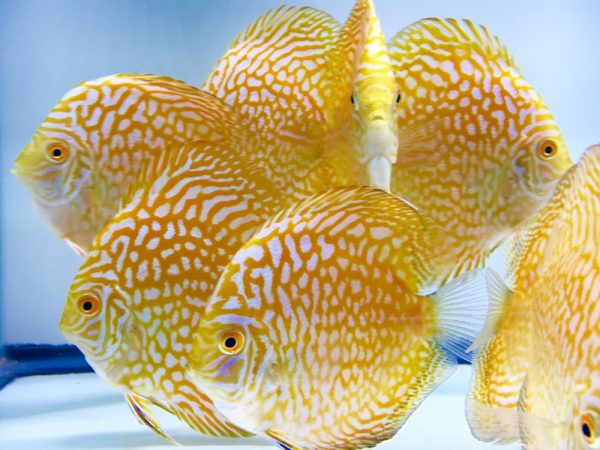
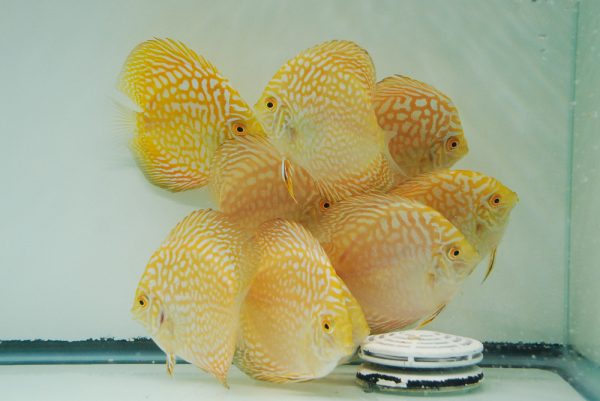
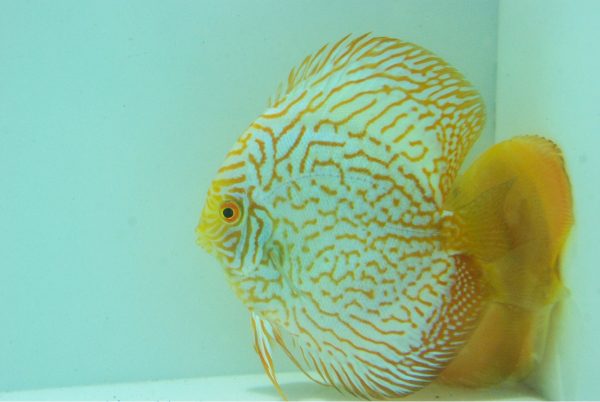
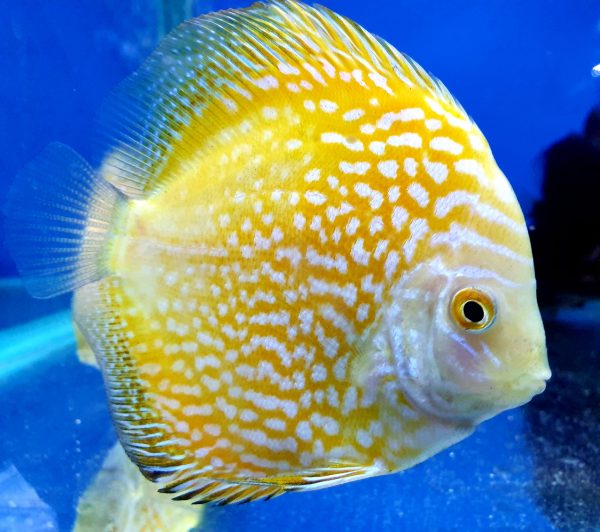
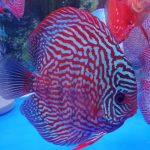
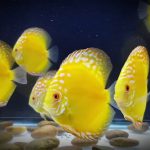
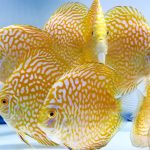
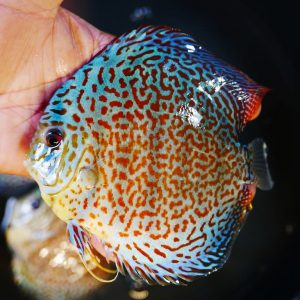
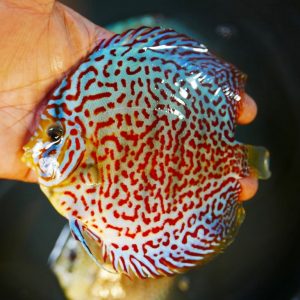
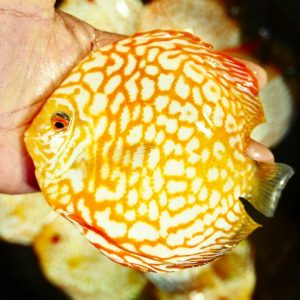
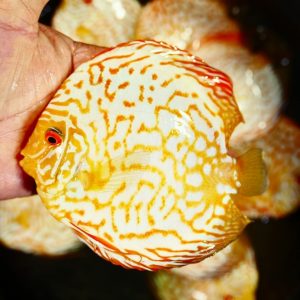
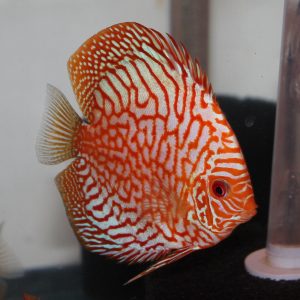
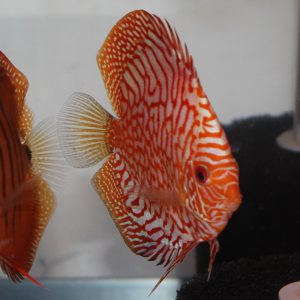
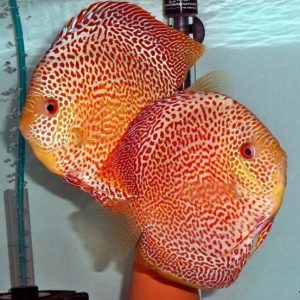
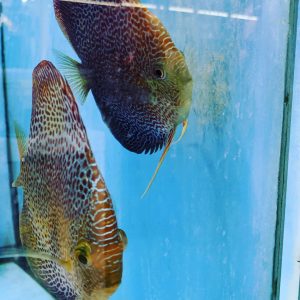
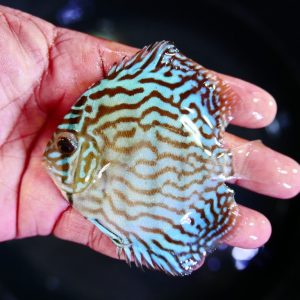
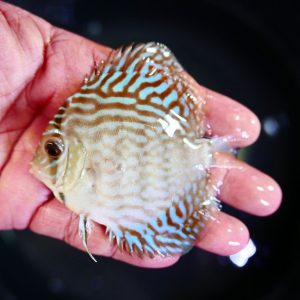
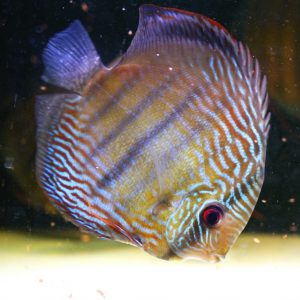
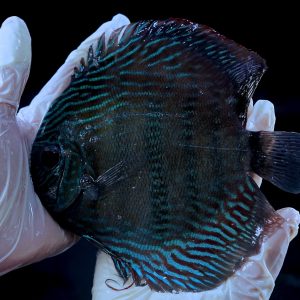
I am happy with the fish you sent, the colors and patterns are to my liking. I appreciate you taking the time to make sure things are good and to make sure I like what was sent.
I will send you pics once they become comfortable in their new surroundings. I have them in a 150 gallon tank.
These are my first collection of Discuss.
Jason
The bag for the...More
Unfortunately, the San Merah never got better. The other 13 are doing well and eating. I included a couple photos of my other tanks.
The bag for the San Merah had lost volume, and when I opened it, the fish was extremely hypoxic trying to gasp air from the room air above the pail. I was a Cardiothoracic Surgeon for 40 years, so I’m familiar with hypoxia. Unfortunate. I would love to have him/her replaced and maybe get a few more fish, as well as those 3 plecos. The tank is 180 gallons. I now have 13 Discus, 6 dwarf gouramis and two small coconut plecos. All the smaller fish probably amount to 1 discus collectively. If I can have 1 fish per 10 gallons = 18 total. So probably 4 additional Discus. They are beautiful.
Package delivered. All fishes alive. Thanks for your picks.
Perfect can't complain at all how much for Altum adults size ? I was wondering to get 4 other, but I want the large I had no option when I got this one.
Hi Michael fish arrived and are absolutely beautiful!! A couple of them do lay down or swim sideway, but that is normal. What do feed the fish at your location? They look great. Activity level is good except for the golden lollipop is little sluggish compared to the others and will sit still nose pointing down at a slight angle which I believe could be a concern. Will keep you posted. Extremely happy with these fish.
The fish arrived yesterday morning and are doing great. I am extremely happy with the ones you picked out for me. They are...More
Michael, the fish arrived ok, all alive and well. Absolutely beautiful and very happy with them! They all went in a 30 gallon qt tank by themselves at 88°F. Light off for the first 48hrs, then turned light on and they accepted food just fine. Been eating well and still are. However, when I woke up this morning I spotted something odd on the yellow pigeon blood. Looks like brown spots/patch above the mouth and the upper mouth is starting to swell. Please help me identify what this is and what the proper treatment should be. I don't want to lose any of these beautiful fish! I have attached pictures of the fish with this email. Thanks! From Michael: That’s called peppering. All pigeon strains have it and it’s normal. Enjoy!
(So much for acclimating them gently and slowly… I took ...More
Everyone arrived alive. They arrived on Friday at 10:10 and I had to leave for work at 11.😧🤭
(So much for acclimating them gently and slowly… I took them out of 1st layer of bags (water was still nice and warm) and started plopping the bags into my tank. Then I started at the back at beginning of the line up and started opening the bags the fish were in and letting tank water in. ((((Repeat)))) (Lights off)(added stress guard to tank)
Long story long, they all were still alive when I got home from work and they all seem to be eating well! I am really excited to see what their colors are going to look like when they grow up. They are just now starting to look like they are feeling more “at home” and colors are starting to reveal themselves. So pretty!!! I didn’t know the eyes lost color too when stressed… the red eyes are starting to appear😍
They are getting to know me already and come over by me when they see me🥰
Yes, everything is fine. I'd like to order some tank mates from you. Let me know when you get Apistogramma agassizii in as well as an algae eater/ bottom feeder. Current aquarium is a 55 but will be upgrading to a 75 or 90 as the discus grow. From Michael: 75g is the minimum tank size for discus keeping. I would upgrade first before acquiring any additional fish.
They were great everything was exactly as I ordered and no losses. Pics are of the fish you're ordering... I've received 10x fish so far.
Hi Michael, I appreciate your picks. They are definitely the most beautiful discus that I have ever owned. Everyone still looks ok except for the yellow one. I send you a picture below. Can you tell me what wrong which it? Any experience from you to help it. Thank you, Michael!
One red was dead yesterday which is completely the ups driver and doesn't look like the second penang is doing well either... the big red one and a white one were as you know the only survivors of the first shipment that I was never actually notified would be arriving and as of right now I've only lost the red from the second order again I know now exactly why they were in such rough shape the driver did not care at all what the label said and when I said something about it he was very nonchalant and dismissive. He basically told me "oh well."
Pictures of my fish tank and the 4 fish that you sent.
I just want to make sure the things were right there's no problem on my end I will order from you in the future no hard feelings here and I am just getting into this so not sure on the colors thank you guys very much have a great evening. Thank you very much for everything I'm enjoying them already.
Hi Michael, I would actually love to get a few more discus for my tank, but I’m worried that my bio load is getting too high. Numbers are good test-wise, except my nitrate level is around 50. I do frequent water changes, and have just put a bunch of live plants in, hoping to bring it down. Actually I have brought the number down, it was over 100 ppm. Otherwise, pH is good, I keep the temp around 88 degrees, which they oddly seem to like. Not sure when I’ll be comfortable putting more discus in the tank. Any nitrate advice other than water changes? I’ll take some pictures and send them to you. Thanks, Steve
Thank you for the quick reply. I have also attached a photo of my tank with your remaining fish. They seem to be healthy and active.
Dear Mr. Li: After receiving a shipping, I noticed the Red Fuji Discus has a lot of black spots on gills and fins. I though that was from the natural born, but after 2 days, others fish stated having black spots on gills, fins, and body. On the day three, all the fish got it. I started raised the temperature to 88 and used API-General Cure for treatment. Try to hold off my second shipment for one week or two. Anything I can do to help my fish. I am new to discus. Thank you, An From Michael: The small black spots are what is called peppering in discus. It is normal for any pigeon strain, and does not indicate the fish are sick.
This is another fish that I love. I know pigeons commonly display some degree of peppering but this fish doesn't have a single black dot on it!
They have finally come out of quarantine and just got introduced to my main tank. They look great! Thank you again.